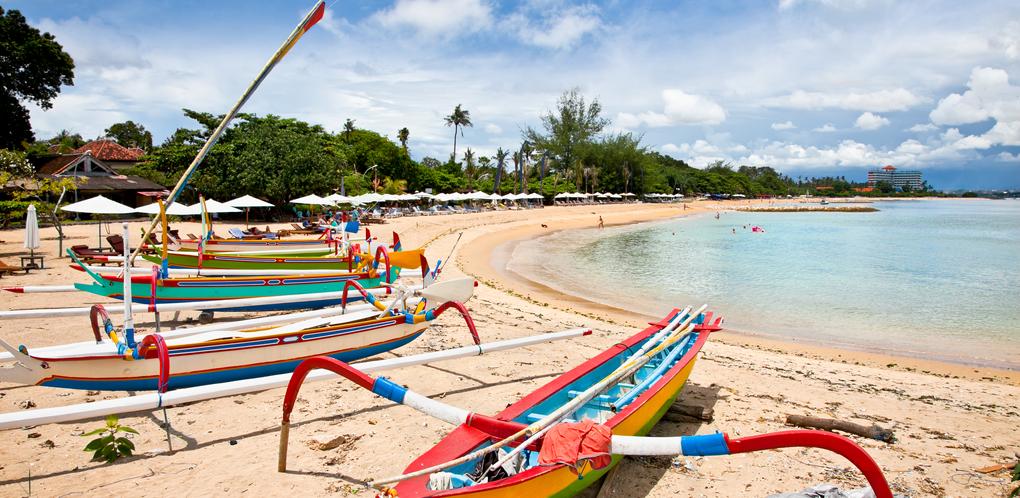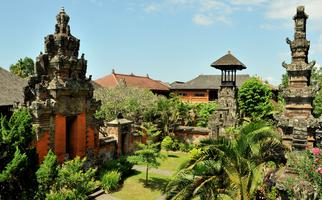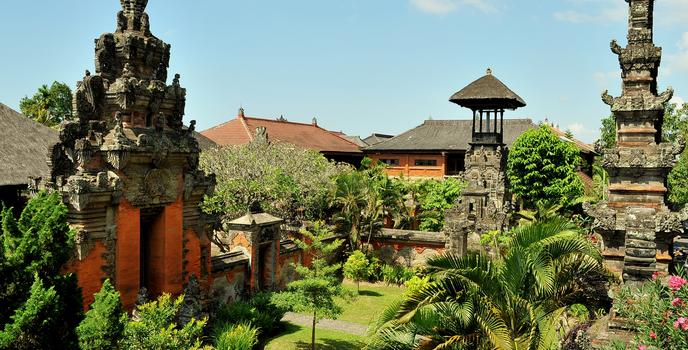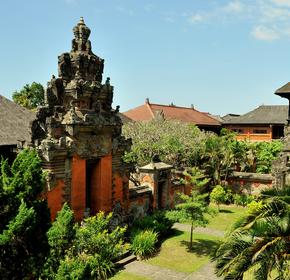1. Lapangan Puputan Badung: Get a Bit of Natural R&R
Get out of the city of concrete and head to the calm, open green-space of Lapangan Puputan Badung. Located in the middle of Denpasar, this city park features a large fountain, multiple statues, and even a playground for children. There is also permanent fitness equipment available for free here so park-goers can really stretch their limbs while getting a much-needed breath of fresh air. Pro Tip: visitors looking to engage with Balinese locals can try striking up a friendly game of over-sized chess in Lapangan Puputan Badung park.
2. Bali Museum: Learn About Bali's Art and History
Built in 1931, the Bali Museum features regional artifacts dating back to the Bronze Age and is easily considered to be the Smithsonian Museum's equivalent in Indonesia. The building is split into four exhibits, which include theatrical masks and instruments in Tabanan, sculptures and paintings in Karangasem, clothing and textiles in Buleleng textiles, and archaeological artifacts in Timur. Displays are explained in English, making it easy to understand the context and significance of each museum piece. Travel tip: visit during the weekday afternoons to avoid the crowds. You may even be able to hear some of the museum staff playing mystical musical instruments while you do!
3. Pasar Badung: Shop Till You Drop
Whether you're looking to do some grocery shopping or souvenir shopping, Pasar Madung Market is one of the best places to make a purchase in all of Bali. Some of the wares available here include textiles, accessories, spices, and local handcrafts. Many locals also come here to find a sense of community and pray, so it is not uncommon for visitors to smell fresh flowers and incense while walking around the stalls. As with most open-air shopping markets in Southeast Asia, the best prices usually come with the local custom of haggling before buying.
4. Goa Gajah: Follow the Elephants
While Goa Gajah doesn't actually contain any elephants, the archaeological park is thought to have received its name from the Hindu lord Ganesh who is depicted in a stone statue within the hidden caves. Goa Gaja was built in the 9th century and was originally a place of quiet meditation. Today there are many structures at Goa Gajah with relics of early Buddhism for visitors to see. On the grounds are also two small streams, a small rice-paddy field, and an excavated pond.
5. Bali Marine and Safari Park: A Unique Open Zoo Experience
Bali Marine and Safari Park offers visitors the chance to expand their horizons with up-close encounters with some of the region's most popular and exotic animals. From zebras to rhinos, elephants to tigers - there's never a shortage of wild animal viewings when visiting the park or staying at the Mara River Safari Lodge. The Bali Marine and Safari Park complex features a safari space, water-park, restaurant, and hotel for an authentic vacation experience. For something truly unique, try taking the night safari tour complete with cultural performances and visits from your favorite nocturnal beasts. The upcoming aviary exhibit is sure to add to the zoo's overall experience upon its completion.
6. Waterbom Park: Feel the Rush of Adrenaline
Located in downtown Kuta, this exciting water park will get your adrenaline pumping. Its various water slides and attractions ensure no one is left out. The smallest kids will have a blast on supervised rides specifically designed for them. Take it easy on the leisurely float down the Lazy River or defy gravity in wild rides like the Twin racer, Superbowl and Boomerang. Have fun on the Constrictor, one of the world's longest waterslides, and experience dramatic twists and turns on the Python.
7. Ubud Royal Palace: Visit Indonesia's Ruling Family
Ubud Royal Palace remains the official residence of Indonesia's monarch Sultan Hamengkubuwono X and the focal point in central Ubud. The palace was built in the early 19th century and has been carefully preserved to the modern day. Currently, Ubud Royal palace acts as both a cultural gathering place and an administrative building. Visitors should take advantage of the local-guided tours and nightly dance performances at the Palace to get true glimpse of traditional Balinese culture.
8. Kuta: Bali's Precious Gem
On the island of Bali, you will find one of the most famous spots around - Kuta. It is arguably the best-known tourist getaway in Bali, mostly because of the long, broad Kuta Beach, with pristine, white sand and turquoise-blue waters, which makes for a surfer's paradise. Previously known as a modest fishing village, it has become a tourist hub, boasting hundreds of thousands of visitors each year. Engage your family in fun-filled activities such as swimming, sunbathing, and boating on the beach. If pushy vendors begin to bother you as you're soaking up the sun, move north along the beach to Legian, Seminyak, or Petitenget for a quieter experience.





